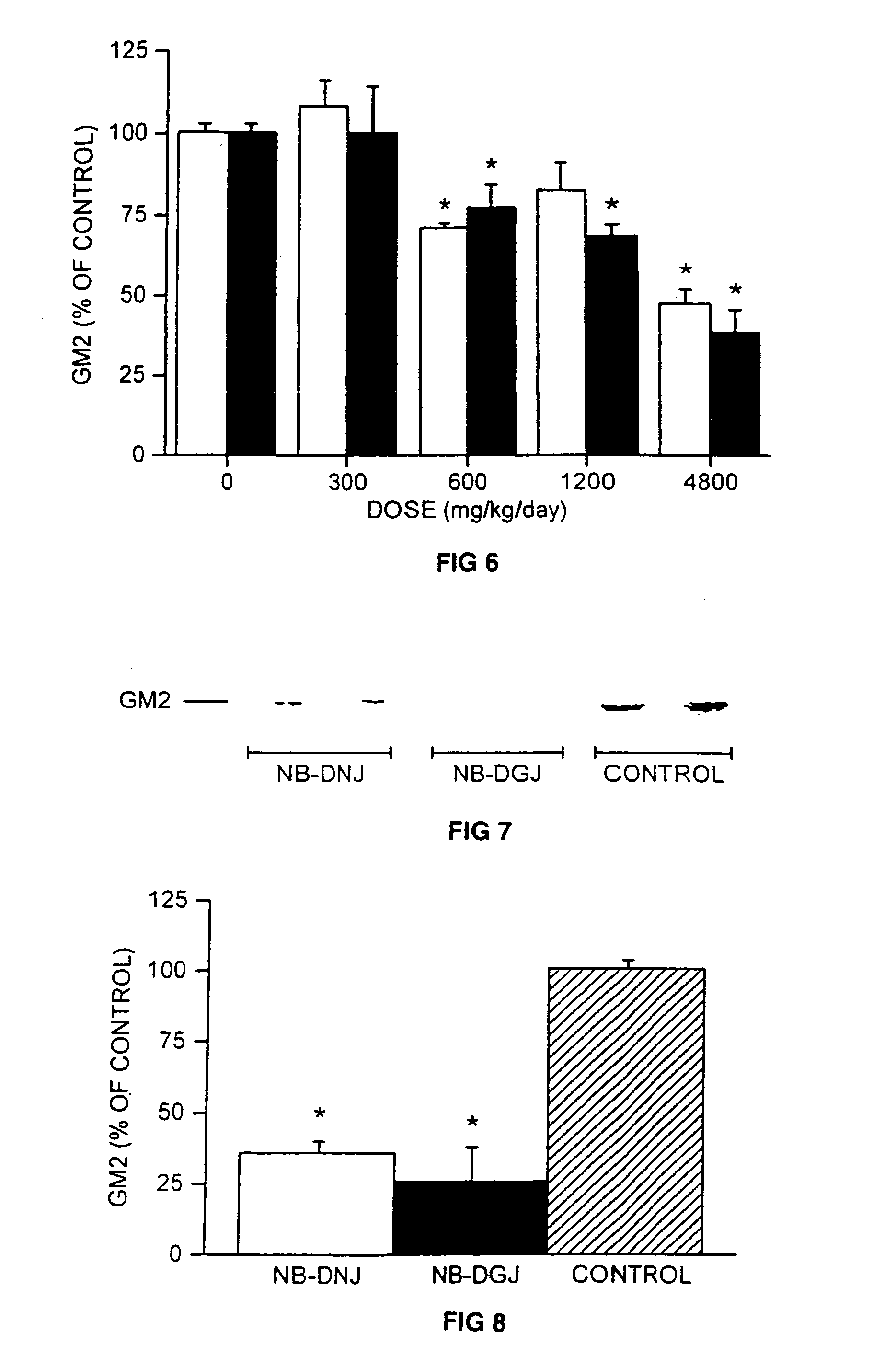Therapeutic compositions and methods of treating glycolipid storage related disorders
a glycolipid and composition technology, applied in the direction of drug compositions, peptide/protein ingredients, metabolic disorders, etc., can solve the problems of weight loss, unsuitable approach for disease involving gsl storage in the cns, and reduce the size of lymphoid organs, so as to increase the rate of neuronal glycolipid degradation, increase the activity of enzymes over time, and improve the effect of enzyme efficacy
- Summary
- Abstract
- Description
- Claims
- Application Information
AI Technical Summary
Benefits of technology
Problems solved by technology
Method used
Image
Examples
example 1
Materials and Methods
[0095]Animals. Female C57BL / 6 mice were housed under standard non-sterile conditions. The mice were provided with water ad libitum and prior to drug administration were fed pelleted chow (expended Rat and Mouse Chow 1, SDS Ltd., Witham, Essex, UK). All experiments were performed on age-matched animals.
[0096]Treatment of Mice with NB-DNJ and NB-DGJ. The mice (6 weeks old) were fed a diet of powdered chow (expended Rat and Mouse Chow 3, ground, SDS Ltd.) or diet containing NB-DNJ or NB-DGJ. The diet and compound (both as dry solids) were mixed thoroughly, stored at room temperature, and used within 7 days of mixing. The mice were maintained on NB-DNJ or NB-DGJ at doses of 300-4800 mg / kg / day for 10 days, or 2400 mg / kg / day for 5 weeks.
[0097]Radiolabelling of NB-DGJ. A galactose oxidase / Na[3H]4B method was used to radiolabel the C6-carbon of NB-DGJ. A solution of NB-DGJ (1.3 mg), galactose oxidase (80 units), and catalase (37000 units) in 200 μl 10 mM sodium phosphat...
example 2
Co-Administration of Ceredase™ and N-B-DNJ
[0103]A group of mice were treated with NB-DNJ at 4800 mg / kg / day for 5 weeks. After a low intravenous dose (5-10 U / kg) of Ceredase™ (Genzyme Corporation) administered as a single injection via the tail vein, serum enzyme activity was measured by taking sequential serum samples from the tail vein to monitor enzyme activity over time. Ceredase™ is a modified form of β glucocerebrosidase. The results are shown in Table 1.
[0104]
TABLE 1Effect of NB-DNJ on circulatory activity and half life of Ceredase ™MousePeak ActivityT1 / 2 (min)Control15.84.227.93.338.01.546.81.8530.01.462.82.0713.61.2817.61.2Mean ± sem11.6 ± 3.12.1 ± 0.4NB-DNJ113.91.7232.14.9324.15.3413.13.0521.03.5668.32.4719.22.8Mean ± sem27.4 ± 7.23.4 ± 0.5
[0105]Ceredase activity and serum half lives appeared to be increased in mice treated with NB-DNJ, suggesting a protective effect of the compound to enzyme clearance. It was concluded that (a) co-administration of NB-DNJ with Ceredase™ do...
example 3
Co-administration of NB-DNJ and Bone marrow Transplantation in a Mouse Model of Sandhoff Disease
[0106]Sandhoff mice were bone marrow transplanted at two weeks of age and drug therapy initiated at 9.5-11 weeks of age (600 mg / kg / day). Survival curves were plotted for each group of animals with each point on the graph representing a death (FIG. 1). The untreated (no BMT, no drug) survived (longest survivor) until 140 days (filled circles), NB-DNJ only (no BMT) survived until 170 days, BMT only (no NB-DNJ) survived until 200 days, and NB-DNJ plus BMT had extended survival from 200-280 days. The data show synergy approximately 13% above additive.
PUM
| Property | Measurement | Unit |
|---|---|---|
| body weight | aaaaa | aaaaa |
| temperature | aaaaa | aaaaa |
| dry weight | aaaaa | aaaaa |
Abstract
Description
Claims
Application Information
 Login to View More
Login to View More - R&D
- Intellectual Property
- Life Sciences
- Materials
- Tech Scout
- Unparalleled Data Quality
- Higher Quality Content
- 60% Fewer Hallucinations
Browse by: Latest US Patents, China's latest patents, Technical Efficacy Thesaurus, Application Domain, Technology Topic, Popular Technical Reports.
© 2025 PatSnap. All rights reserved.Legal|Privacy policy|Modern Slavery Act Transparency Statement|Sitemap|About US| Contact US: help@patsnap.com



